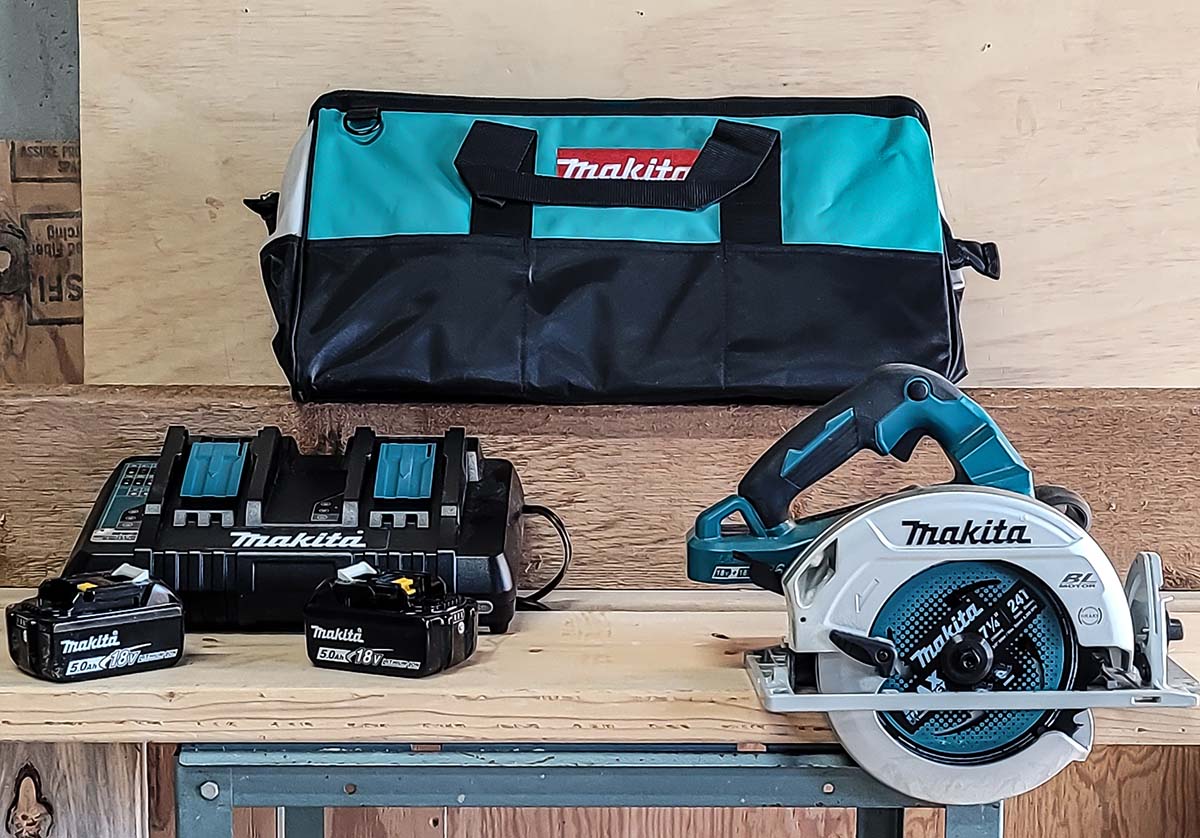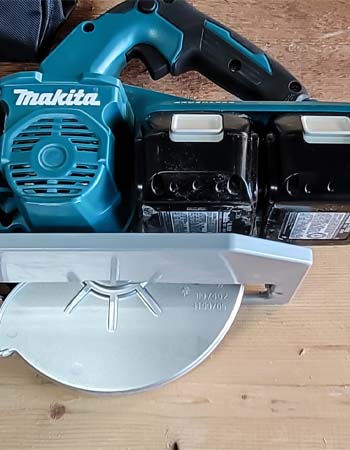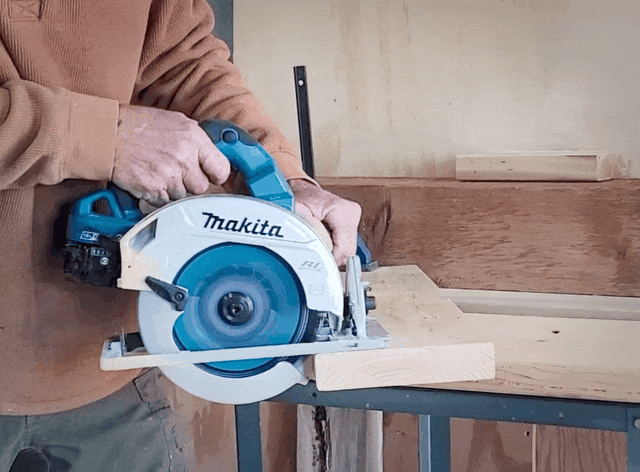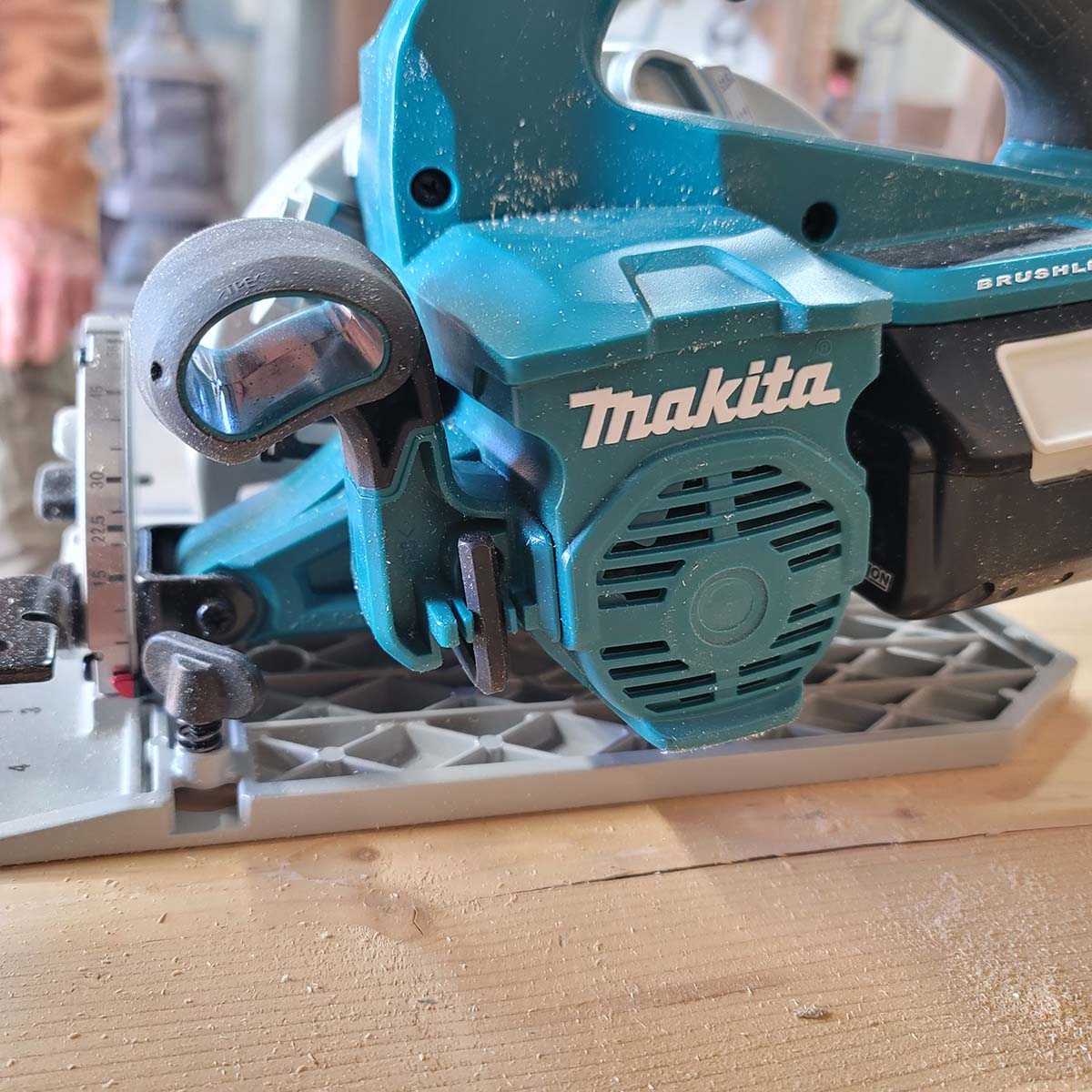

We may earn revenue from the products available on this page and participate in affiliate programs. Learn More ›
Circular saws are among the last handheld power tools to go cordless, likely because they require immense power to sustain a strong cutting force through dense wood. Until recently, pros seemed to prefer corded electric circular saws, but improvements in battery power and brushless motor technology are starting to change that. Several of today’s best circular saws are now battery-powered. Manufacturers like Makita ensure high power by putting two batteries on the tool.
I tested the Makita XSH06PT along with nine other top-performing circular saws. The XSH06PT earned top honors due to several factors, including quality materials, a rugged build, and long-lasting battery power that delivers 6,000 revolutions per minute (rpm). Ahead, find out how the XSH06PT fared in our hands-on testing and whether it’s the right tool for your workshop.
Makita XSH06PT 36V Cordless Circular Saw: At a Glance

Rating: 9.2/10
PROS
- Powered by two 18-volt (V) batteries (36V) (included)
- Cutting depth up to 2⅝ inches at 90 degrees
- The brushless motor produces 6,000 rpm
- Magnesium base plate and blade guard
CONS
- No rafter hook included, but one can be purchased separately
- Lithium-ion batteries must be recharged occasionally
- Plastic body except for plate and guard
Get the Makita XSH06PT 36V Circular Saw at:
- Amazon for $196
- The Home Depot for $259
- AceTool for $199
- ToolBarn for $199
- Factory Authorized Outlet for $199
What Is the Makita 36V Cordless Circular Saw?
At first glance, the Makita XSH06PT is just another circular saw, but look closer. What sets this Makita circular saw apart from its cordless competitors are two 18V lithium-ion batteries that fit side by side on the tool. This gives the Makita a total of 36V, double the battery power of competitive models that feature just one battery. This is a 7¼-inch model—the most common size for circular saws—so it has a lot of competition in the power tool market. It’s a sidewinder model, which means the motor is located beside the blade rather than behind it.
The Makita Corporation has a strong presence in power tool manufacturing. For the past half century, it’s been supplying the construction industry with high-quality tools for building and remodeling. The 36V Makita cordless circular saw is a top-notch tool for both pros and DIYers. With both batteries installed, the saw weighs 10½ pounds, so it’s lightweight enough to control but offers a bit of bulk to help stabilize it while cutting.

How Much Cutting Power Does the Makita Circular Saw Offer?
The saw’s brushless motor means reduced internal friction, so the XSH06PT delivers 6,000 blade rpm. In testing, I made numerous straight and bevel (angled) cuts with the saw.
The XSH06PT made quick work of crosscuts on studs—cutting through them like butter. The saw was fast, smooth, and accurate when I made long rips on plywood. It has a 2⅝-inch cutting depth at 90 degrees, slightly deeper than many of its competitors, which offer just 2½-inch depth or less.
Since cutting power also has to do with the power source, having two 18V batteries on deck makes a big difference. The Makita cordless circular saw didn’t bog down or heat up when I made repeated cuts in plywood and dimensional lumber.

How Easy Is the Makita Cordless Circular Saw to Use?
As far as circular saw operation goes, it doesn’t get much simpler than the Makita 36V circular saw. The batteries snap into the ports easily but fit snugly. It takes a little extra pressure on the release buttons to remove them, but that’s how I like it. I don’t want batteries that could work loose from their ports during operation.
One of the top reasons for buying a circular saw is its ability to cut bevels as well as straight cuts. Adjusting the angle of the cutting blade on the Makita was a breeze. It comes with a quick-change lever, so there was no need for me to hunt down any tools to change the blade’s angle, which was an annoying problem with older circular saws. In addition, this saw comes with positive stops at the standard cutting angles of 22½, 45, and 56 degrees, so I could quickly change the cutting angle, and it would snap into one of those stops. I could also adjust it to other custom angles and lock the blade.
The cutting depth on the Makita is also easy to adjust via a quick-change lever, so I didn’t spend a lot of time going from deep cuts to shallow cuts. Replacing the blade on the saw still requires a tool, but Makita has gone the extra mile and included the device (a hex wrench) right on the saw’s body. I pulled out the hex wrench, loosened and removed the blade, put in a new one, and tightened it without having to dig through a tool chest to find the correct wrench.
How Does the Makita Cordless Circular Saw Compare to a Corded Circular Saw?
This is the big question with today’s new cordless circular saws. While lithium-ion technology is improving all the time, it’s still not as reliable as plugging a power tool into an electrical outlet, which will provide maximum power without needing to recharge any batteries.
But constant power aside, the Makita 36V cordless circular saw provides benefits that can’t be found on a corded model. I tested this saw in my workshop and outdoors—far away from any outlet—so portability is a significant benefit. Cords limit power tools, and they can lead to accidents and injuries if the user or other workers trip on the cords.
If I could only choose one circular saw—either a corded 7¼-inch model or the Makita XSH06PT—I’d select the Makita in most nonshop situations. It offers as much cutting power as most corded models, and by purchasing a couple of extra lithium-ion batteries, the tool will run without any downtime. However, in a shop-only situation, I might opt for a corded model since I have readily available outlets and wouldn’t need to worry about charging batteries.

Is the Makita Cordless Circular Saw Right for You?
For pros who’ve waited until now to invest in a cordless circular saw, the Makita XSH06PT is a pleasant surprise. While it will require charging batteries, the benefits of working without dragging a cord around are a game changer. Plus, with a brushless motor and two 18V batteries on deck, the XSH06PT provides ample power, and even an hour into near-constant cutting, it didn’t bog down or lose steam. Climbing through rafters or on ladders or scaffolding without an electrical cord to worry about is a bonus.
A downside is the lack of a rafter hook, a must-have for those working at heights. Fortunately, one can be ordered separately, and I suggest investing a little more to buy the hook to ensure the saw doesn’t fall to its demise.
DIYers will also appreciate the power and versatility of the Makita cordless circular saw. It cuts so smoothly and quickly that it’s likely to be a favorite on any building project, and at just 10½ pounds, it shouldn’t cause undue wrist and arm fatigue. Find out more about the best circular saws and how they performed in our hands-on testing to determine the best choice for any shopper’s projects.
Get the Makita XSH06PT 36V Circular Saw at:
- Amazon for $196
- The Home Depot for $259
- AceTool for $199
- ToolBarn for $199
- Factory Authorized Outlet for $199
The Best Circular Saws
With two 18V lithium-ion batteries and a brushless motor that delivers up to 6,000 rpm of cutting power, the Makita XSH06PT excels among 7¼-inch cordless circular saws. In addition, it held its own very well when tested against the best corded and cordless circular saws of various sizes. As battery technology continues to improve, I look forward to testing even higher-voltage batteries that push cordless tools beyond the reach of their corded brothers.
